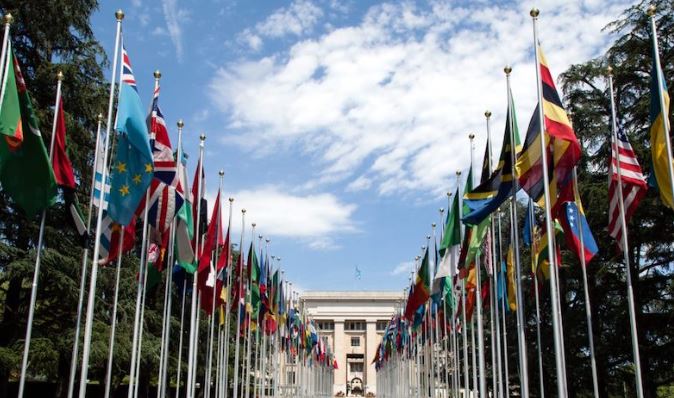
“The landmark Global Climate Treaty, signed by representatives from over 200 nations at the historic Geneva Summit, marks a pivotal moment in the global fight against climate change. This unprecedented agreement lays the groundwork for coordinated international action to address the pressing environmental challenges facing our planet.
| Key Highlights of the Global Climate Treaty | Details |
|---|---|
| Emissions Reduction Targets | Legally binding commitments to reduce greenhouse gas emissions by at least 45% below 2010 levels by 2030, with the ultimate goal of achieving net-zero emissions by 2050. |
| Renewable Energy Transition | Signatories pledged to accelerate the transition to renewable energy sources, including solar, wind, and hydropower, with a target of 80% renewable energy generation by 2040. |
| Climate Finance | The treaty established a climate finance mechanism to provide $100 billion annually to support developing nations in their efforts to mitigate and adapt to climate change. |
The sheer scale of this agreement, with 200 nations coming together to address the global climate crisis, is a testament to the growing international consensus on the urgency of this issue. The Geneva Summit played a crucial role in facilitating the complex negotiations and forging this historic compromise, paving the way for a more sustainable and resilient future.
Key Provisions and Objectives of the Treaty
At the heart of the Global Climate Treaty are ambitious targets for greenhouse gas emissions reduction and the accelerated transition to renewable energy. Signatories have committed to legally binding goals, including a 45% reduction in emissions by 2030 and net-zero emissions by 2050. This represents a significant step up from the previous Paris Agreement, reflecting the growing scientific consensus on the need for more aggressive action.
The treaty also establishes a robust climate finance mechanism, which will channel $100 billion annually to support developing nations in their efforts to mitigate the impacts of climate change and adapt to its consequences. This represents a crucial component of the agreement, recognizing the disproportionate burden faced by vulnerable communities and the importance of global cooperation and equitable solutions.
Significance of 200 Nations Signing the Treaty
The fact that 200 nations, representing the vast majority of the global population and economic output, have signed this climate change agreement is a remarkable achievement. It demonstrates a newfound level of international cooperation and a shared understanding of the existential threat posed by climate change.
This broad participation is essential for the treaty’s success, as it ensures that emissions reduction efforts are coordinated and comprehensive, covering the world’s largest greenhouse gas emitters as well as nations that are most vulnerable to the impacts of climate change. The universal nature of the agreement also strengthens its legitimacy and moral authority, making it more difficult for any single nation to opt out or undermine its implementation.
Implementing the Treaty: Challenges and Opportunities
While the signing of the Global Climate Treaty represents a significant milestone, the real test will be in its effective implementation. Signatories will face a range of challenges, including the need to align national policies and regulations with the treaty’s objectives, mobilize the necessary financial resources, and overcome technological and logistical barriers to the renewable energy transition.
However, the treaty also presents unprecedented opportunities for innovation, job creation, and sustainable economic growth. The shift towards clean energy and low-carbon technologies will spur investments and drive the development of cutting-edge solutions, creating new green economy industries and employment prospects.
The Role of the Geneva Summit in Negotiating the Treaty
The Geneva Summit played a pivotal role in facilitating the complex intergovernmental negotiations that led to the adoption of the Global Climate Treaty. Over the course of several intense weeks of discussions, diplomats from around the world worked tirelessly to overcome political differences, reconcile competing interests, and forge a consensus on the treaty’s key provisions.
The summit’s host city, Geneva, provided an ideal neutral setting for these multilateral negotiations, drawing on its long history as a hub of international diplomacy. The presence of global leaders, subject matter experts, and civil society representatives ensured that all perspectives were considered and that the final agreement reflected a truly collaborative approach to addressing the climate crisis.
Anticipated Environmental and Economic Impacts
The successful implementation of the Global Climate Treaty is expected to have far-reaching environmental and economic impacts. By achieving the targeted emissions reductions and accelerating the transition to renewable energy, the treaty has the potential to significantly mitigate the worst effects of climate change, including rising sea levels, extreme weather events, and the degradation of natural ecosystems.
At the same time, the treaty’s provisions for climate finance and technological cooperation will help developing nations build resilience, adapt to the changing climate, and unlock new economic opportunities in the green economy. The anticipated growth in clean energy industries, sustainable infrastructure, and environmental conservation efforts will create millions of green jobs and drive sustainable economic development around the world.
Ensuring Accountability and Enforcement
The success of the Global Climate Treaty will ultimately depend on the ability of signatories to ensure accountability and enforcement of its provisions. This will require the establishment of robust monitoring and reporting mechanisms, as well as effective compliance mechanisms to address any non-compliance or backsliding.
The treaty’s transparency and review processes will be crucial in this regard, enabling regular progress assessments and the identification of areas where additional support or intervention may be needed. Maintaining a strong political will and fostering a culture of collective responsibility among signatories will be essential for upholding the treaty’s commitments and ensuring its long-term success.
Transitioning to Renewable Energy Under the Treaty
The Global Climate Treaty places a strong emphasis on accelerating the transition to renewable energy sources, with the goal of achieving 80% renewable energy generation by 2040. This will require a coordinated effort to scale up solar, wind, and hydropower capacity, as well as invest in energy storage and smart grid technologies to ensure a reliable and resilient energy system.
Governments, private sector actors, and civil society will all have a crucial role to play in driving this energy transformation. Policies such as carbon pricing, renewable energy targets, and incentives for clean technology adoption will be essential for creating the necessary market conditions and investment climate to support the renewable energy transition.
Protecting Vulnerable Communities and Ecosystems
The Global Climate Treaty recognizes the disproportionate impact of climate change on vulnerable communities and fragile ecosystems, and includes provisions to address these concerns. The climate finance mechanism will channel resources to help developing nations and marginalized populations adapt to the changing climate, build resilience, and mitigate the risks posed by extreme weather events, sea level rise, and environmental degradation.
Additionally, the treaty emphasizes the importance of protecting biodiversity and conserving natural habitats, which are crucial for maintaining the ecological balance and supporting the livelihoods of indigenous communities and small-scale farmers. This holistic approach to climate action and sustainable development is essential for ensuring that the benefits of the treaty are equitably distributed and that no one is left behind in the global effort to address the climate crisis.
Ongoing Efforts to Expand the Treaty’s Reach
While the Global Climate Treaty represents a significant milestone, the work to address the climate crisis is far from over. Signatories and international organizations are already exploring ways to expand the treaty’s reach and deepen its impact, including by:
– Encouraging non-signatory nations to join the agreement and contribute to the global effort
– Developing sectoral agreements and industry-specific initiatives to drive emissions reductions in key high-emitting sectors
– Fostering cross-border cooperation and regional integration to address transboundary climate challenges
– Strengthening monitoring and verification mechanisms to ensure transparency and accountability
– Exploring innovative financing solutions and carbon market mechanisms to mobilize additional climate finance
By maintaining this momentum and continuously adapting the treaty to evolving scientific knowledge and technological advancements, the global community can ensure that the Global Climate Treaty remains a robust and effective framework for addressing the climate crisis and securing a sustainable future for all.
Collaborative Approaches Across Sectors
The success of the Global Climate Treaty will depend on the ability of governments, private sector actors, civil society, and international organizations to work together in a coordinated and collaborative manner. This will require aligning policies, regulations, and investment strategies across various economic sectors, from energy and transportation to agriculture and manufacturing.
By fostering cross-sectoral partnerships and multi-stakeholder initiatives, the global community can leverage synergies, share best practices, and mobilize the necessary resources and expertise to drive the low-carbon transition. This collaborative approach will be essential for overcoming technological barriers, scaling up innovative solutions, and ensuring a just and equitable climate transformation that benefits all.
The Treaty’s Legacy and Long-Term Implications
The Global Climate Treaty signed at the Geneva Summit has the potential to leave an indelible mark on the global response to climate change. By establishing a comprehensive and legally binding framework for emissions reduction, renewable energy deployment, and climate finance, the treaty lays the groundwork for a fundamental transformation of the global economy and a more sustainable and resilient future.
The treaty’s long-term implications extend far beyond its immediate environmental impact, as it also has the potential to catalyze technological innovation, job creation, and sustainable economic development around the world. As the global community continues to build on the momentum generated by this historic agreement, the Global Climate Treaty may come to be seen as a pivotal moment in the global fight against climate change and a testament to the power of international cooperation and collective action.
Conclusion
The signing of the Global Climate Treaty at the Geneva Summit represents a groundbreaking achievement in the global effort to address the climate crisis. With the participation of over 200 nations, this unprecedented agreement sets the stage for coordinated and ambitious emissions reduction efforts, a rapid transition to renewable energy, and the mobilization of climate finance to support vulnerable communities and developing nations. While challenges remain in the implementation and enforcement of the treaty, the collective determination and the transformative potential of this agreement offer hope for a more sustainable and resilient future for our planet.
Frequently Asked Questions
What are the key provisions of the Global Climate Treaty?
The Global Climate Treaty includes legally binding commitments to reduce greenhouse gas emissions by at least 45% below 2010 levels by 2030, with the goal of achieving net-zero emissions by 2050. It also establishes a climate finance mechanism to provide $100 billion annually to support developing nations in their efforts to mitigate and adapt to climate change, and sets ambitious targets for the transition to renewable energy, aiming for 80% renewable energy generation by 2040.
How does the Global Climate Treaty differ from the Paris Agreement?
The Global Climate Treaty represents a significant step up from the Paris Agreement, with more ambitious emissions reduction targets, a stronger focus on renewable energy deployment, and a more robust climate finance mechanism. While the Paris Agreement relied on voluntary commitments, the Global Climate Treaty includes legally binding provisions, ensuring a higher level of accountability and enforcement.
What are the key challenges in implementing the Global Climate Treaty?
Implementing the Global Climate Treaty will require overcoming a range of challenges, including aligning national policies and regulations with the treaty’s objectives, mobilizing the necessary financial resources, and addressing technological and logistical barriers to the renewable energy transition. Maintaining political will and fostering a culture of collective responsibility among signatories will also be crucial for ensuring the treaty’s long-term success.”





